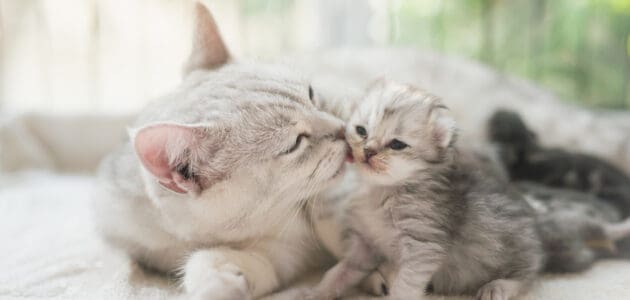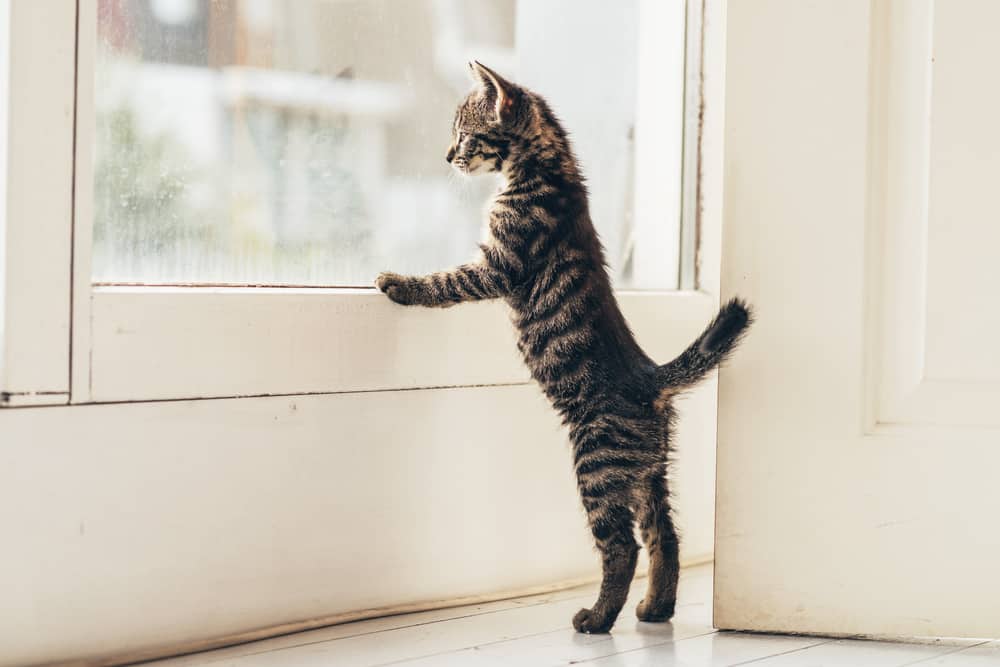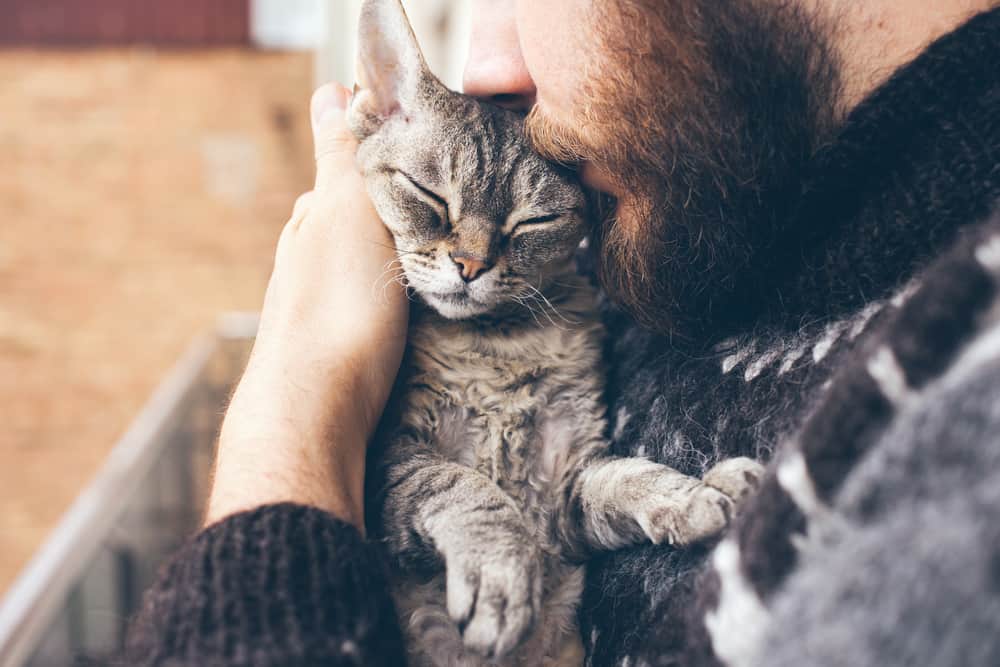When Do Cats Stop Growing?

Any cat owner has likely wondered about how big their pet will get, especially the owners of kittens. While it may seem like your feline friend may never stop growing, eventually they will reach a point in their lives where they can be regarded as fully grown.
Many factors affect when exactly your cat will stop growing and how big they grow to be. In this article, we will discuss the important elements that contribute to a cat’s growth and the full growth cycle of a cat. With this information, you should be able to determine when your cat has stopped growing.
At What Age Do Cats Stop Growing?
Most cats reach their full physical size between the ages of 18 months and 5 years. Which growth cycle stage (and what age) they reach their full size depends on several factors, which we’ll explore in more detail below.
What You Should Know About Cat Growth
Cats go through many different phases as they grow. In order to understand when exactly your cat stops growing, we need to discuss the growth cycle of cats and the factors that affect the maturity of your pet.
What Determines Maturity?
Cat maturity is determined by 3 main factors: size, social maturity, and reproductive maturity. When your kitten has reached certain milestones in each of these categories, they can be regarded as fully grown.
The Growth Cycle of a Cat
The growth cycle of cats gives a general guideline that you can follow to ensure your kitten or cat is reaching age-related milestones. Much like with human children, an evolving set of needs accompanies each age level.
Kitten
The kitten stage takes place from the moment a kitten is born until they are approximately 6 months old. This stage has rapid growth and requires constant supervision to ensure that the kittens are receiving a large amount of calorie intake and proper life enrichment activities.
This is also the time in which cats start learning to become social as they interact with their littermates and their parents. You should interact with your kitten regularly as they start to move around in order to increase their comfort and amenability around humans.
Junior
The next phase of cat life takes place from 7 months until they are 2 years old. This is the stage that cements a cat’s social maturity and the step in which most cat breeds reach their full size, though there are some exceptions to this.
During this time, most cats will also reach sexual maturity. In males, this happens between 7 months of age and a year old; in females, this happens around 7 months of age, but can occur around 5 or 6 months in certain cats.
Adult
The adult cat stage takes place between approximately its third and sixth years. All breeds of cat will have reached their full size around 4 or 5 years old, and a cat’s personality will be fully developed. This is the prime of your cat’s life, and they will be their most active, playful, and healthy during this time. Adult cats require a well-balanced diet and dedicated playtimes to help them maintain their health.
Mature
Mature cats are aged between 7 and 10 years old. This is the stage of life in which your cat starts to slow down and become a little more of a couch potato. This is also the time of life in which health issues start to show up, including dental, kidney, and bladder diseases. Excessive weight gain is another issue that can become a problem in this stage of life as your cat starts to burn fewer calories.
It may be helpful to become familiar with signs of illness in cats while also being sure to take your pet for their annual check-up to catch any preventable issues.
Senior
Cats that reach senior life are aged between 11 and 14 years old. It may be beneficial to switch your cat over to a dedicated senior food during this time – wet food can be especially helpful in giving your cat the easily digestible nutrients they need. Senior cats tend to sleep often and may lose a little bit of weight. However, they can still have moments of activity and playfulness.
Super Senior
Super senior cats are all kitties aged 15 and up. These cats are much less active than their younger counterparts and tend to eat less. It is important to maintain a balanced diet for your super senior cat and make sure they are not rapidly losing or gaining weight, as this can put a strain on their organs.
Cat Growth Summary
Through looking at the growth cycle of a cat, we are able to tell that most kittens stop their rapid growth spurts around their first year of life. After that point, some cats will continue to grow slowly until they reach approximately a year and a half old to 2 years old. Certain breeds, such as ragdolls and Maine coon cats, will continue to grow until they are 4 or 5 years old.
Factors That Affect Cat Growth
As cats grow, there are several external and internal factors that can affect their final size and when they stop growing.
Nutrition
Proper nutrition is one of the most important factors that affect cat growth. If your cat does not get the right amount of nutrients in their first year of life, there is a possibility that their growth will be stunted. If you notice that your cat looks especially small after its first year, you may want to consult with a vet.
To ensure proper growth throughout kittenhood, always be sure to feed your kittens a quality food. You should change this food again after their first year and when your cat enters its senior years to ensure they are always eating a diet balanced for their age.
Breed
As we mentioned above, certain breeds take longer to reach their full size. The most notable cats for this are ragdolls and Maine coons, but even if your cat is mixed, they may have specific genetics that slow down their growth.
You can expect your cat to grow rapidly in the first year of their life. At this point, some cat breeds are completely done growing. Others will continue to grow for another 6 months or all the way up to 4 or 5 years old.
Medical Conditions
Certain medical conditions, like diabetes and bone issues, can affect a cat’s normal growth cycle. They can alter the final size of your cat and potentially stop your cat growing before the normal time frame. If you suspect your cat has a potential medical condition, you should take them to a veterinarian as soon as possible.
Spaying or Neutering
Spaying or neutering your kitten or cat is a common factor in causing altered growth. If your kitten is fixed too early, there is a chance that the hormone changes will stop their growth, leaving them stunted. Spaying or neutering adult cats may lead to a sudden increase in size even if they have already stopped their regular growth.

Determining How Big Your Cat Will Get
If you’re interested in trying to predict how big your cat will get before they reach approximately a year old, there are several tricks you can use to develop an estimate.
Do the Math
This method works well if you are raising your cat from a kitten. All you need to do is weigh your cat when they are 16 weeks old. You can then take that number and double it. This final number is a good estimate of approximately how big your cat will be when fully grown.
Check Their Legs
Looking at your cat’s back legs can be extremely helpful in determining their final size. Very tall back legs typically indicate that your cat will be larger, at least in height.
Examine the Family Tree
If you happen to know the family members of a kitten, you may be able to tell how big they will grow to be. Looking at the size of any fully grown siblings and the parents of your kitten can give you a rough estimate of your pet’s final size.
However, this method may be difficult to do if you have adopted your kitten from a rescue organization or do not know any of its family members.
Average Sizes of Popular Cat Breeds
Wondering if your cat’s size is normal? Check out these average sizes for some of the most popular cat breeds to get a good idea of the healthiest size for your cat.
- American Short or Longhair: Males average between 11 and 15 pounds, and females average between 6 and 12 pounds. This average is also fairly accurate for mixed breed cats.
- Ragdolls: Males average between 12 and 20 pounds, and females average between 8 and 15 pounds.
- Main Coons: Males average between 13 and 18 pounds, and females average between 9 and 12 pounds.
- Siamese: Both males and females average between 6 and 12 pounds.
- Sphynx: Males average between 8 and 11 pounds, and females average between 6 and 8 pounds.
- Persian: Males average between 9 and 14 pounds, and females average between 7 and 11 pounds.
- Bengal: Males average between 10 and 15 pounds, and females average between 8 and 10 pounds.
Keep in mind that these are just general size guidelines for these cat breeds. Your cat may end up smaller or larger based on any number of the factors we discussed above. If you have concerns about your cat’s size or think they may be under or overweight, be sure to consult your veterinarian as soon as possible.

Keeping an Eye on Your Cat’s Weight
Once your cat is fully grown, you should be keeping an eye on their weight; any significant weight loss or gain can indicate underlying issues.
To check if your cat is the correct weight no matter what their average size it supposed to be, run your hand gently across their ribs and spine. You should be able to feel their bones with a thin layer of fat covering them. If all you feel is fat with no trace of bones, your cat is overweight. If all you feel is bones and not much thicker skin or fat, your cat is underweight.
Additionally, your cat should not have a low-hanging layer of fat coming from their belly (this is not to be confused with the very natural primordial pouch that is visible on some cats). When looked at from above, their stomach should not be bulging on either side. Both being obese and being underweight can severely impact your cat’s health and quality of life. If you notice any of these changes, consult with your vet to get your kitty’s size back to average.
Understanding Your Cat’s Growth Needs
Throughout your cat’s life, they will have an evolving set of nutritional, social, and exercise-related needs. To keep up with your furry friend, it is important to understand each phase of your cat’s life and monitor their growth carefully so you can provide it with the healthiest life possible. And remember, no matter the size that your cat turns out to be, they will always need a lifetime full of love.




